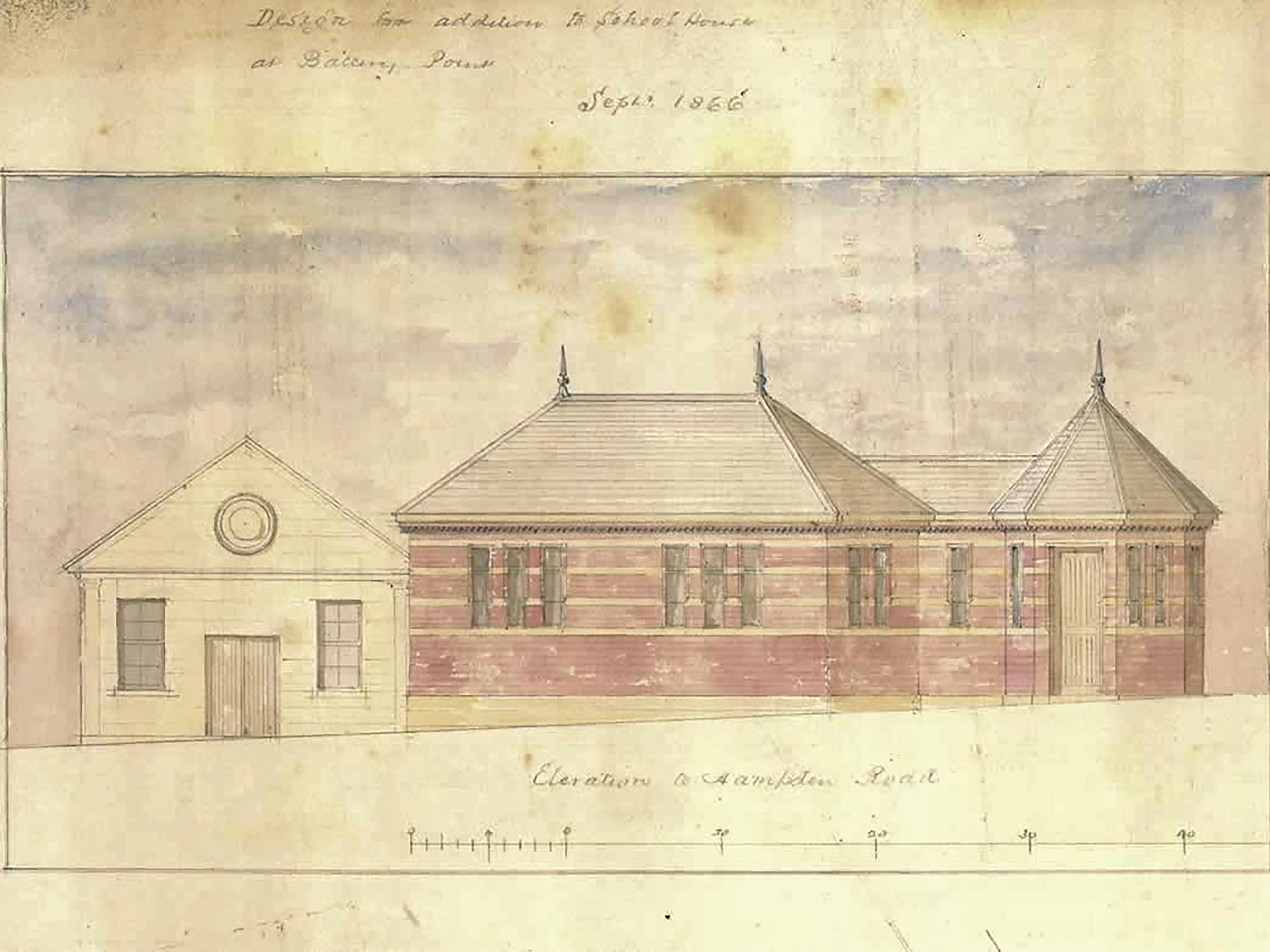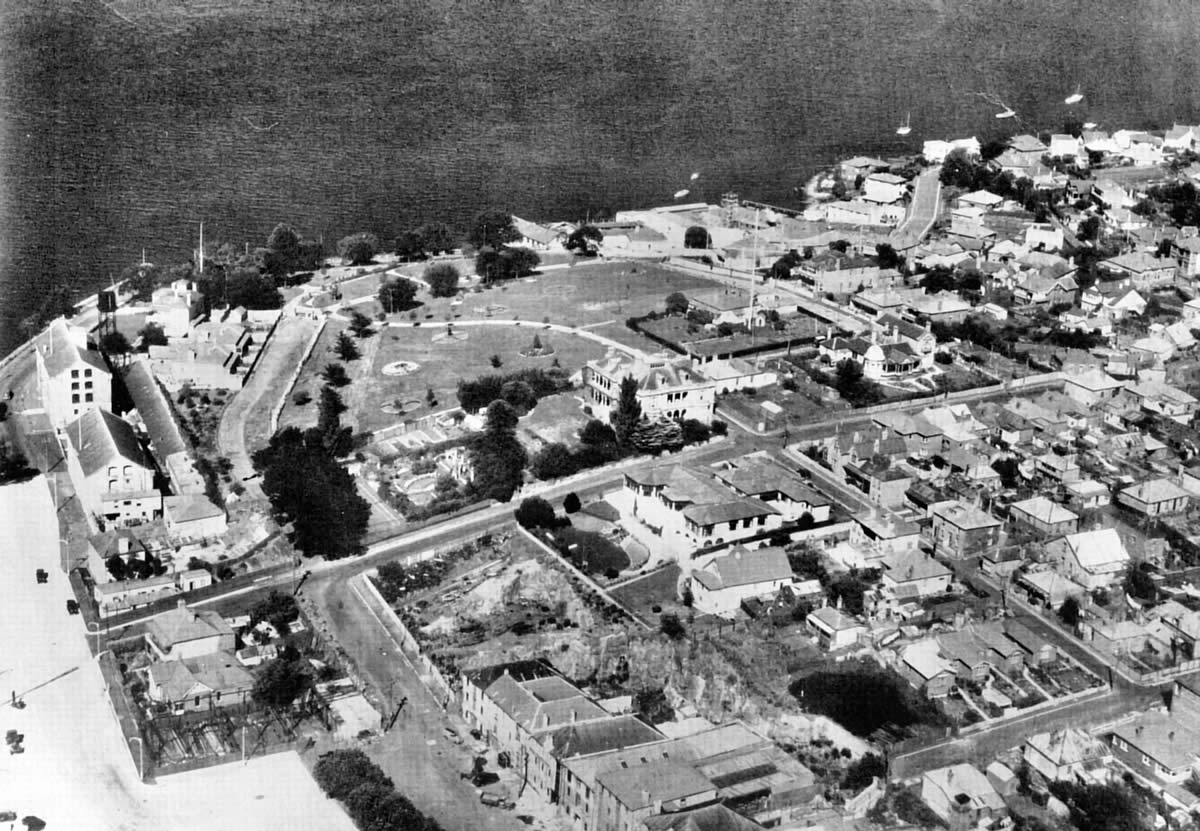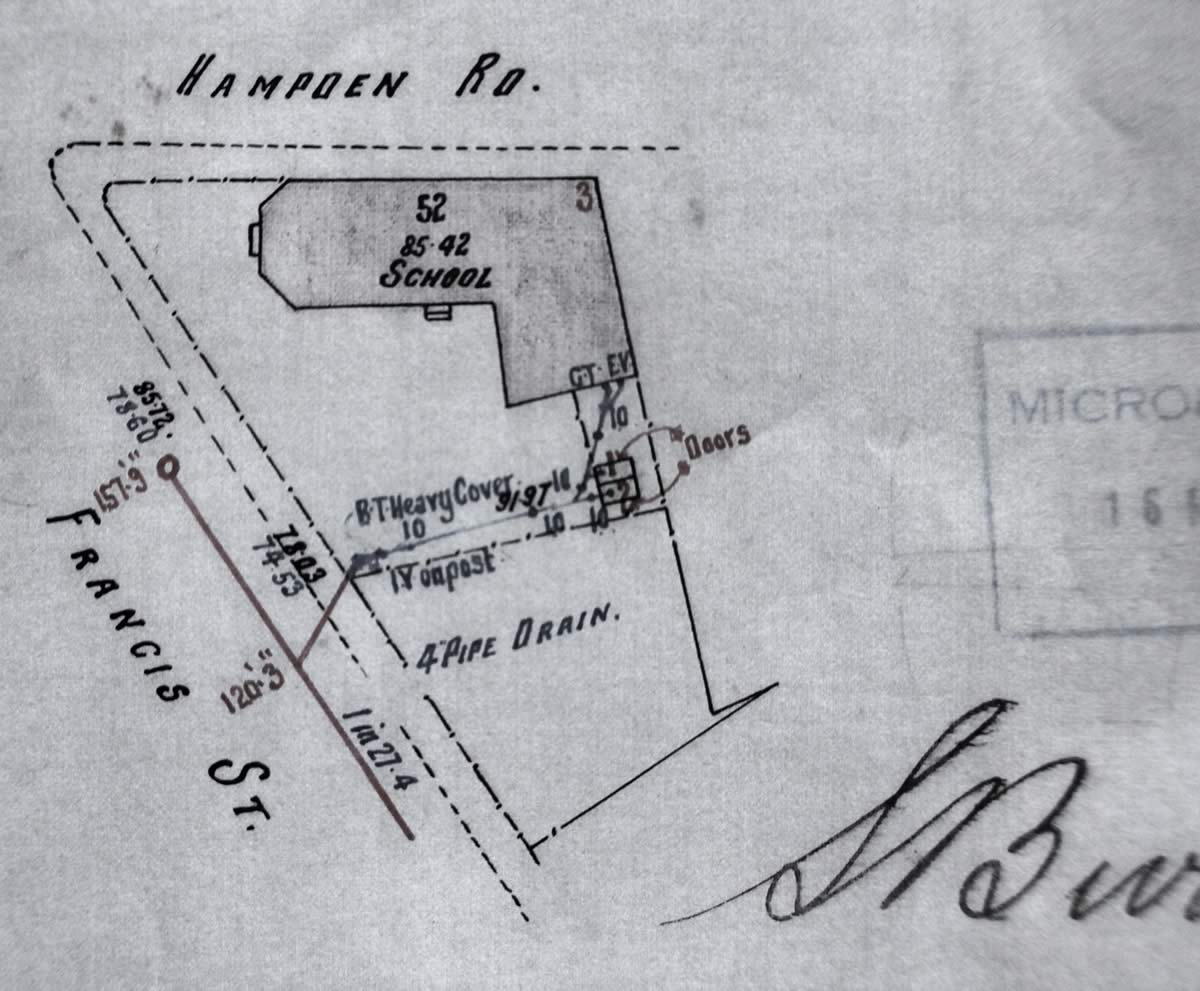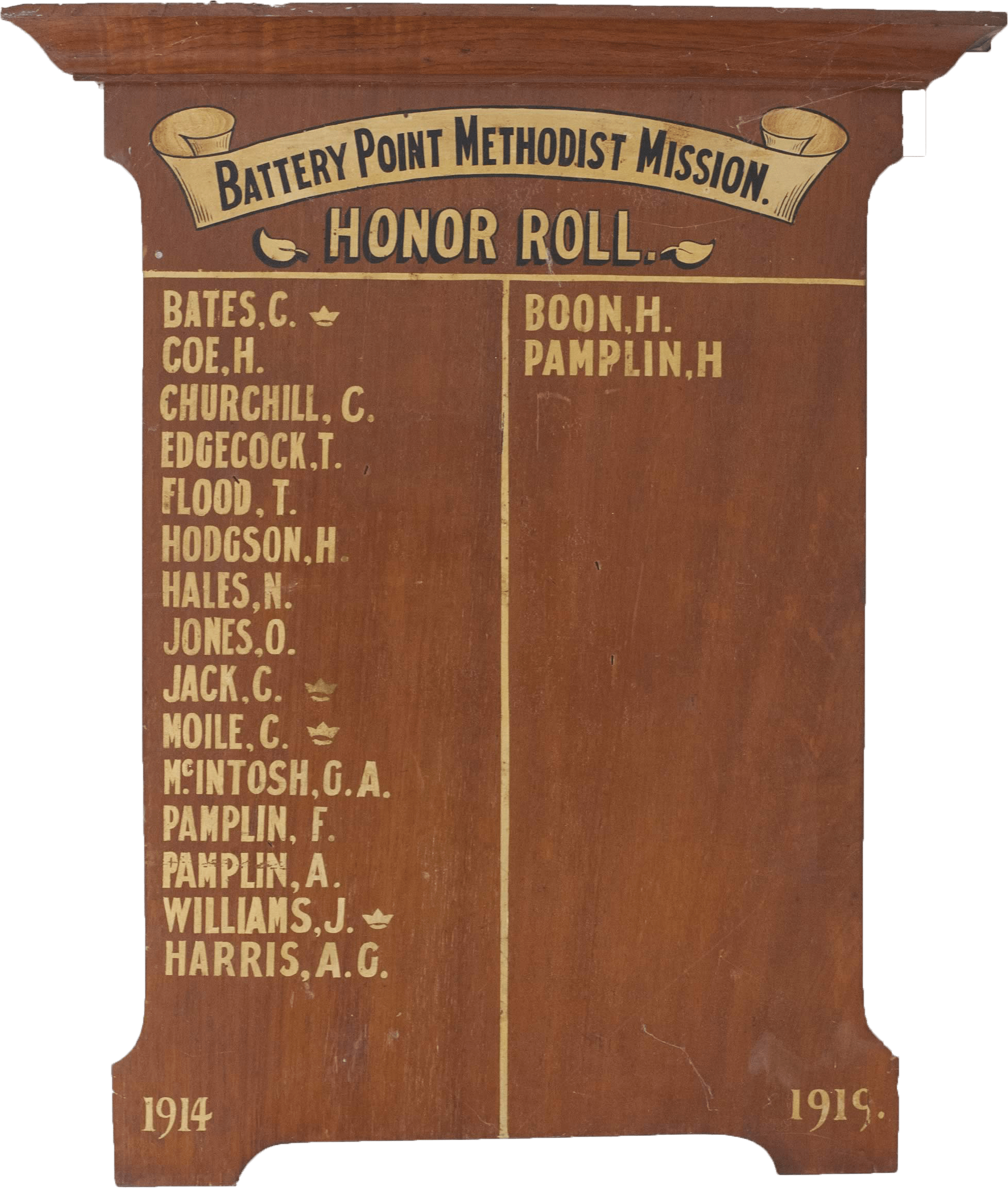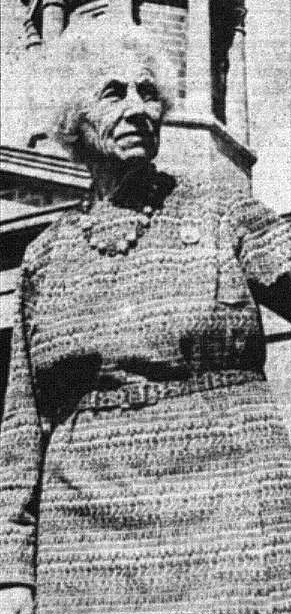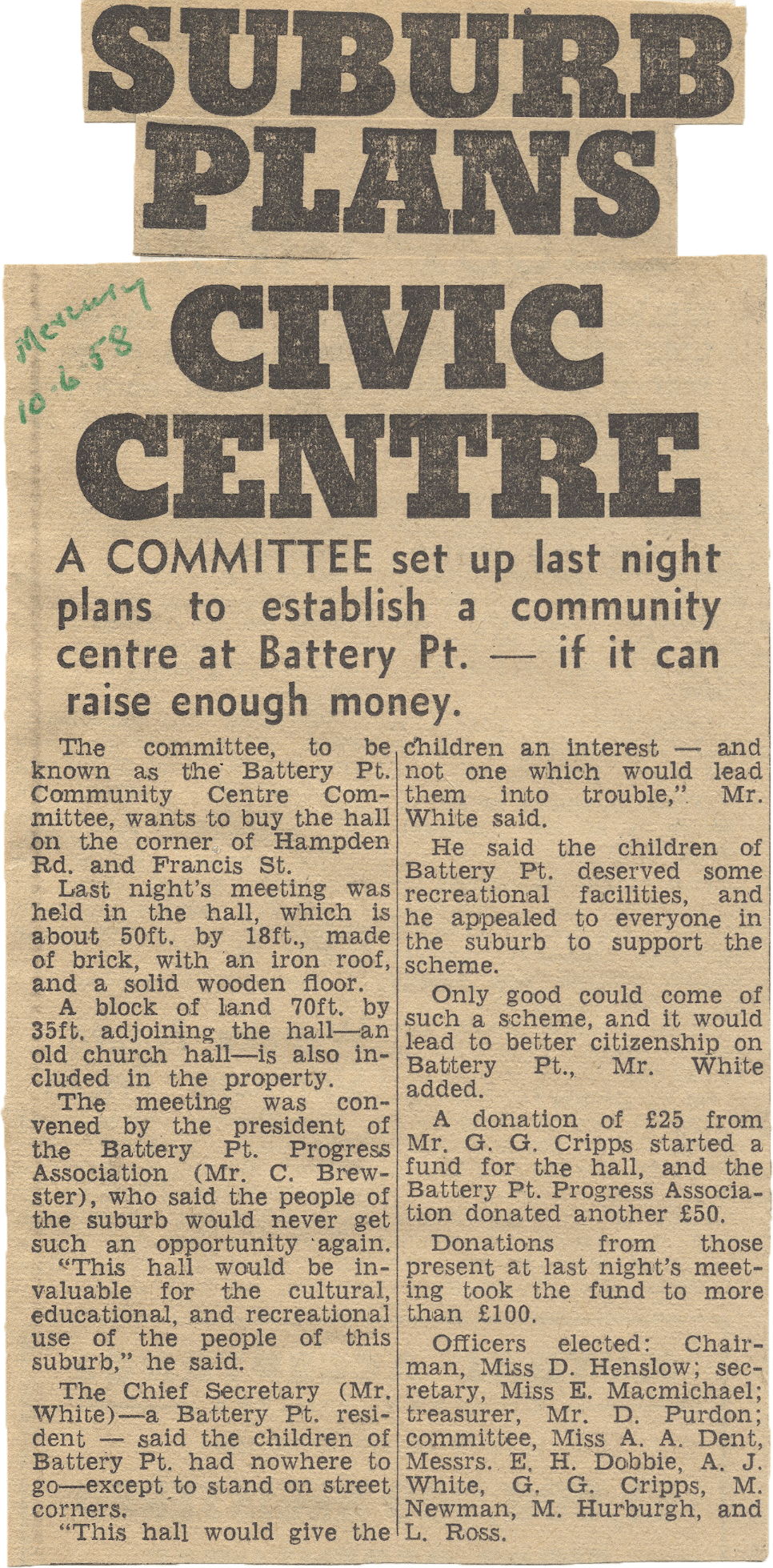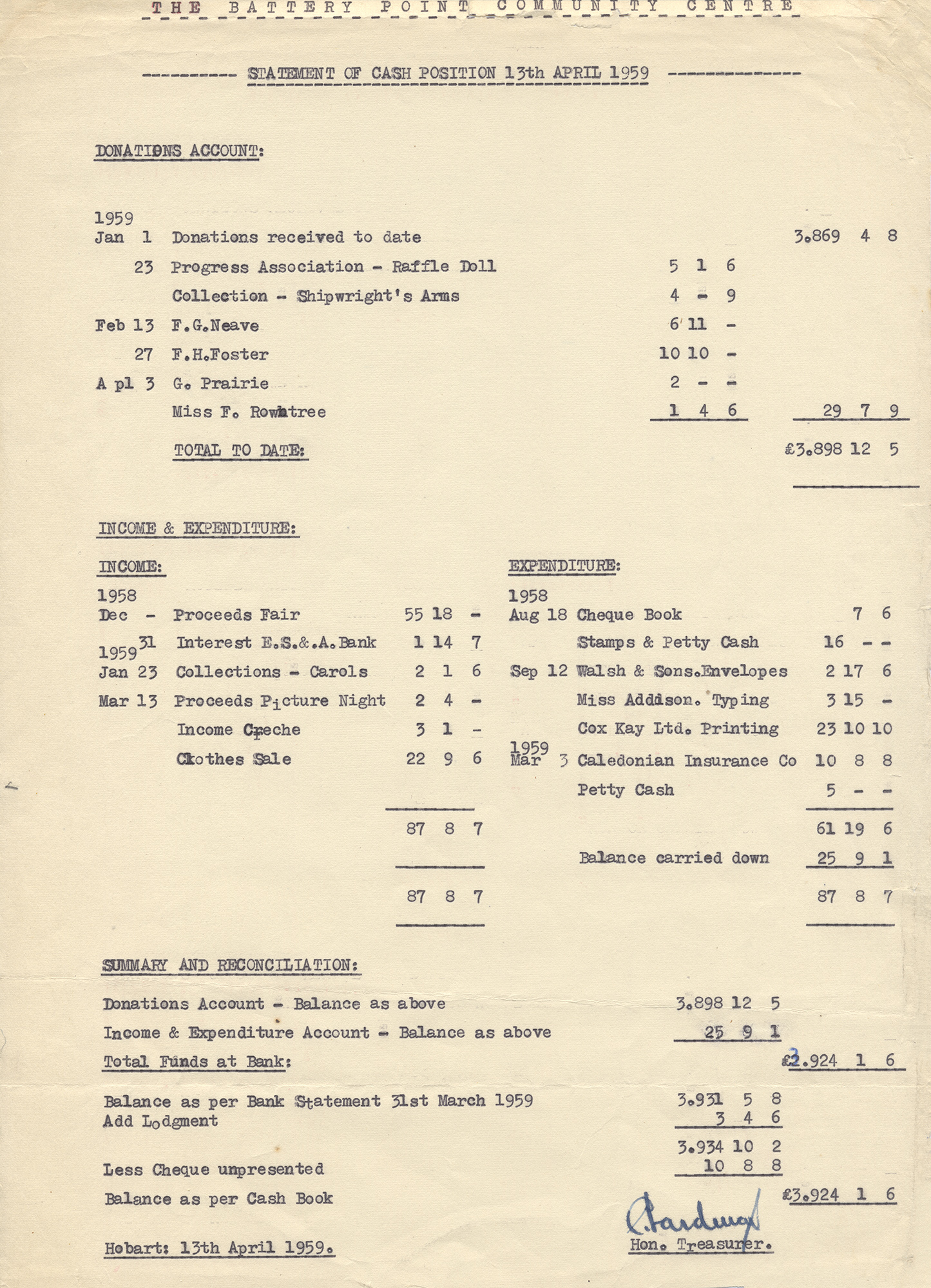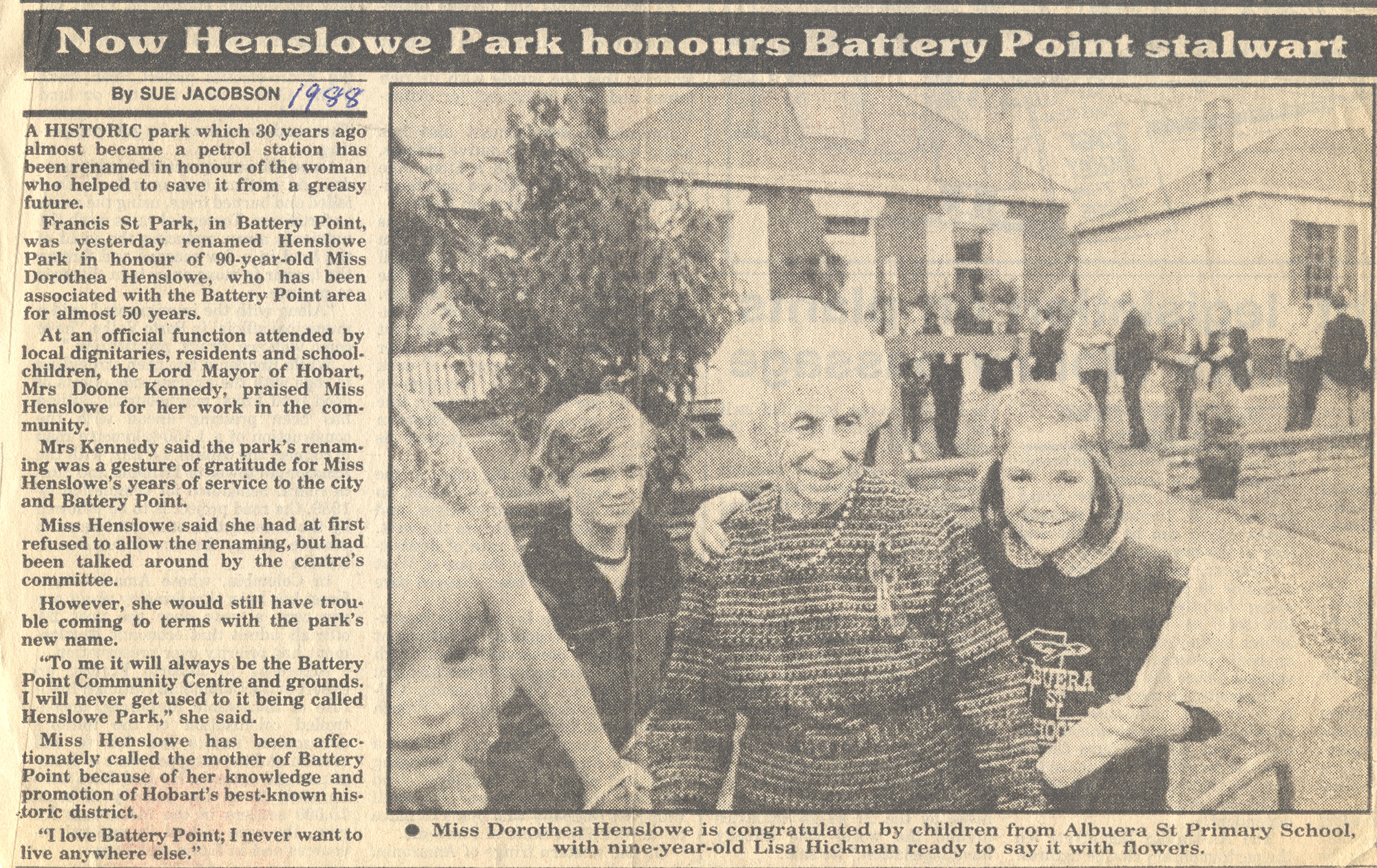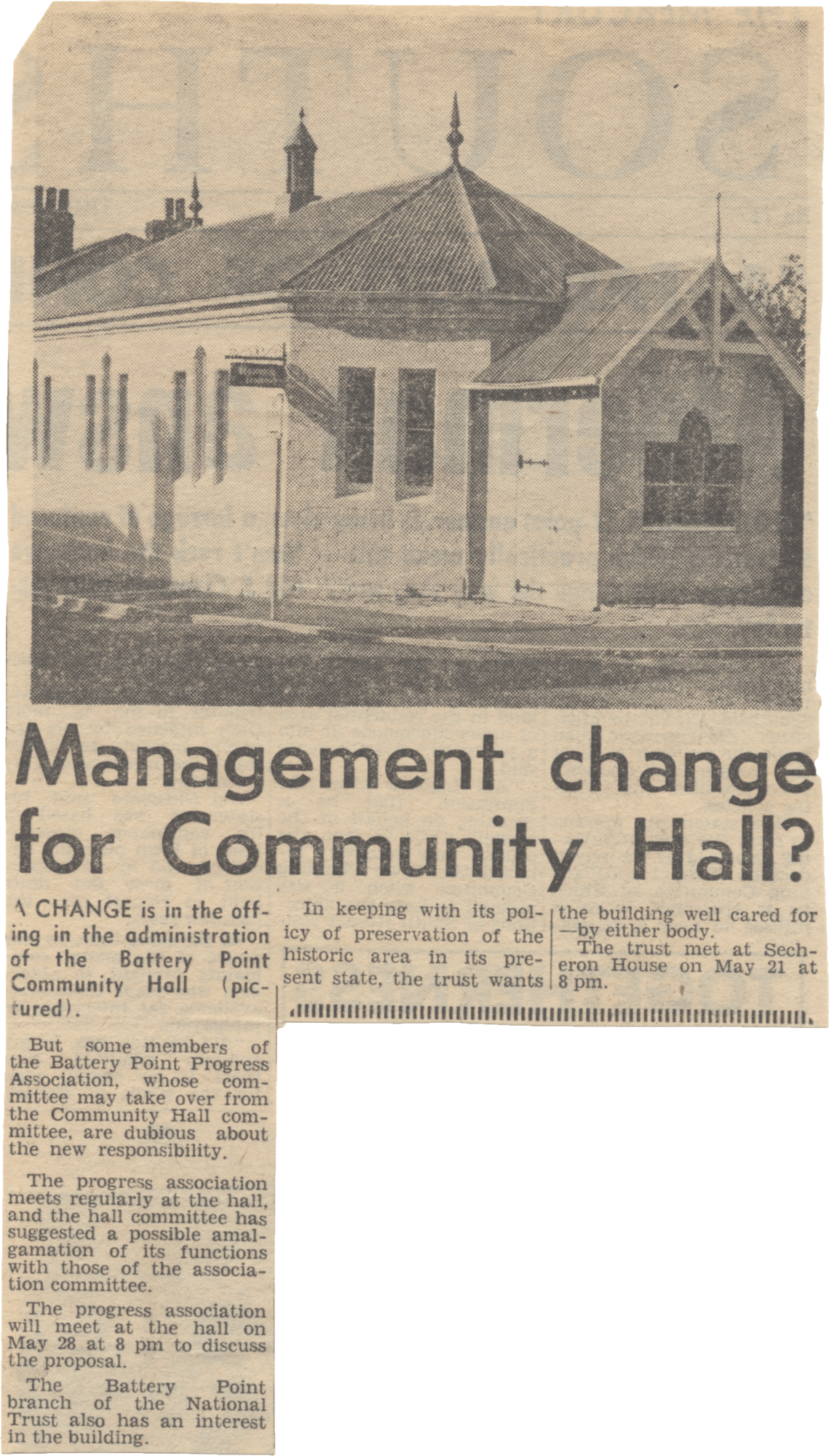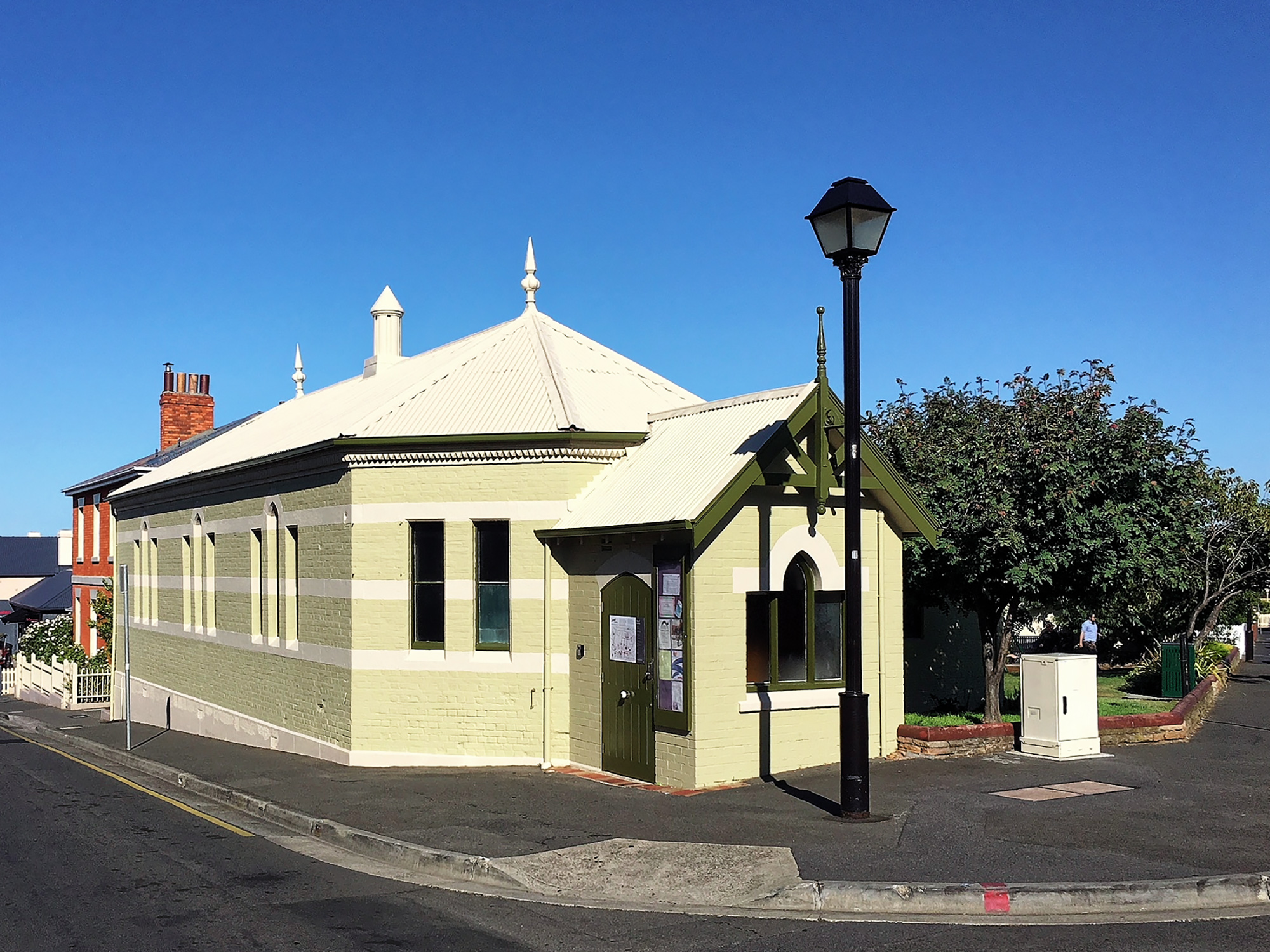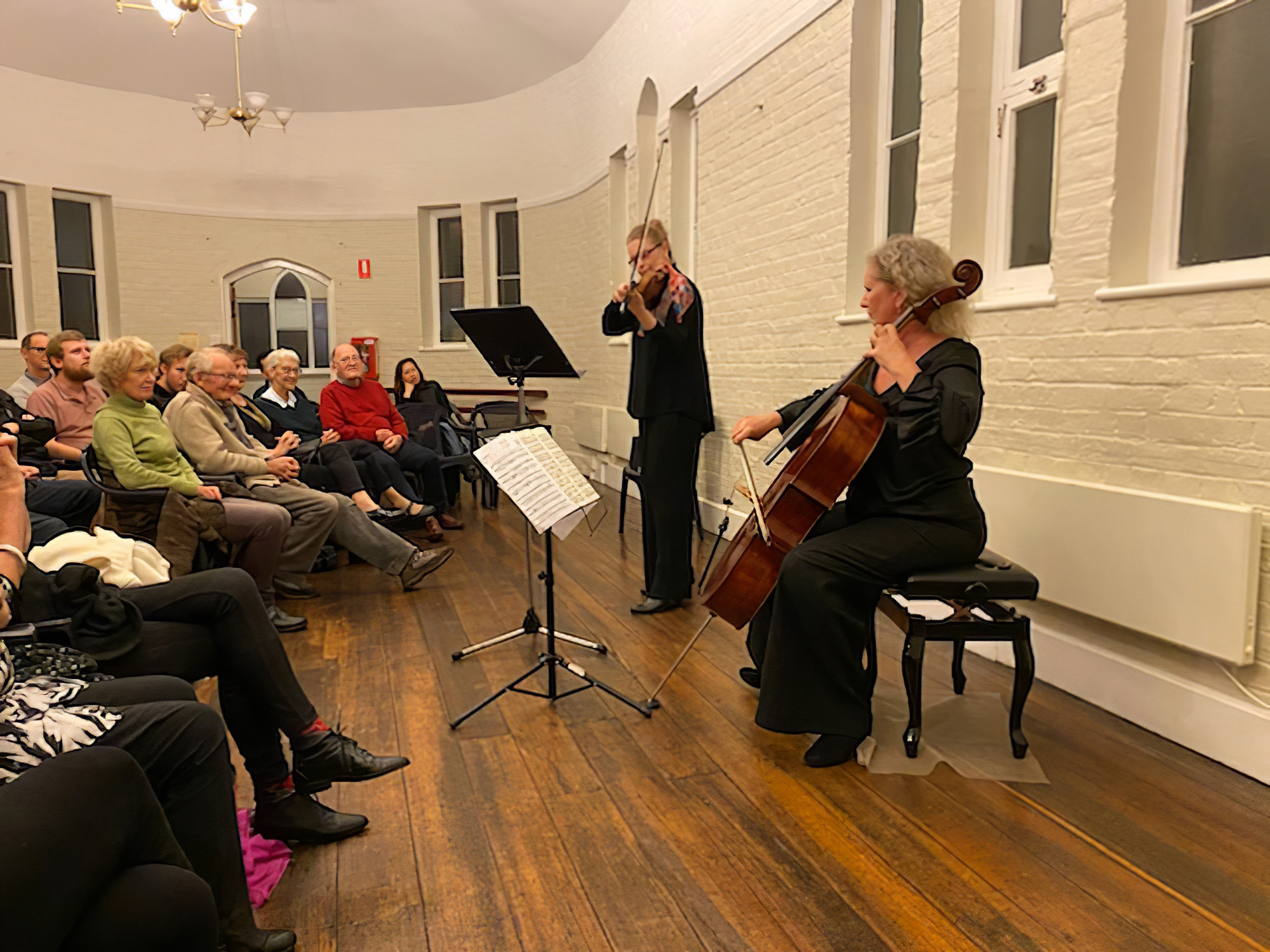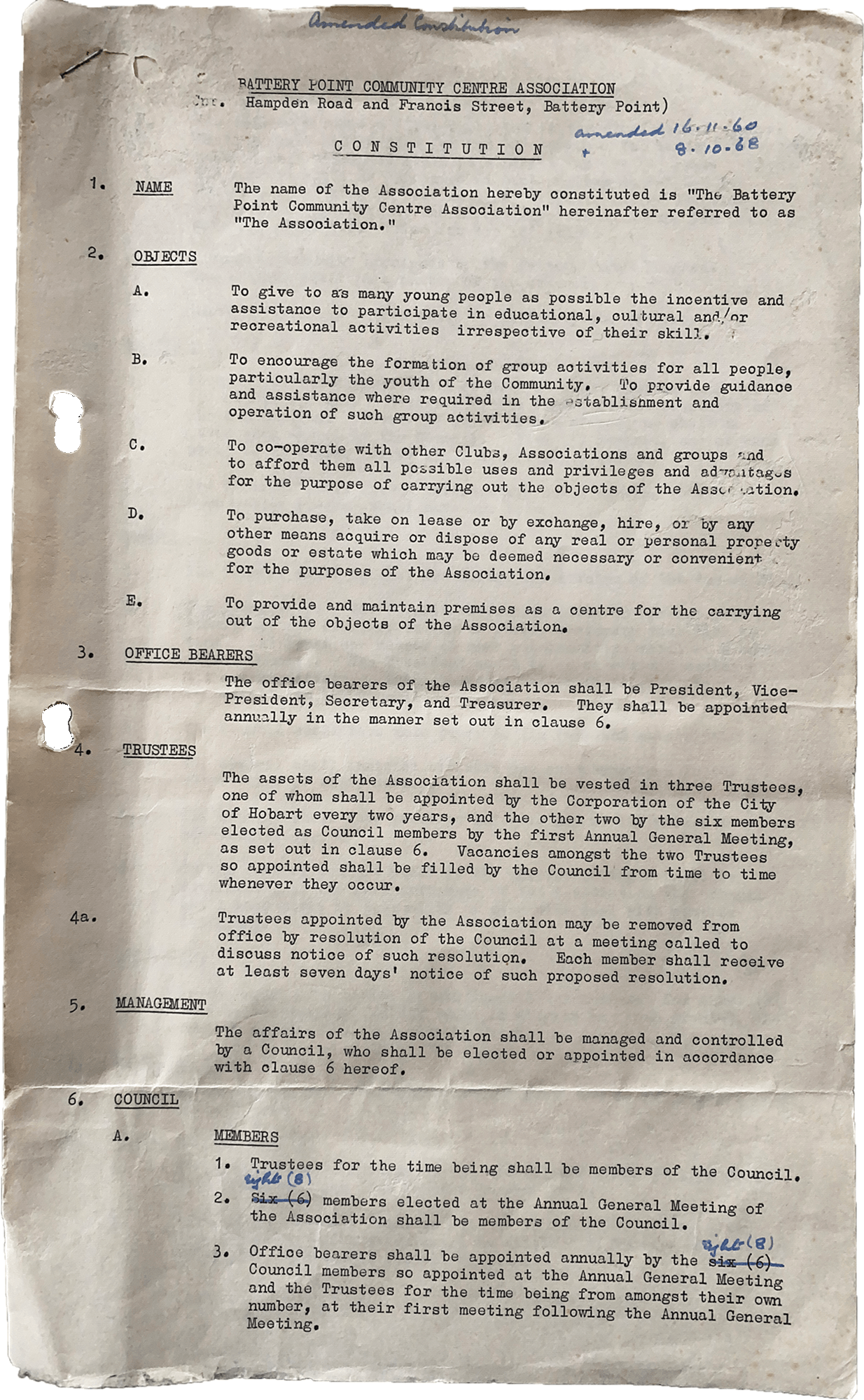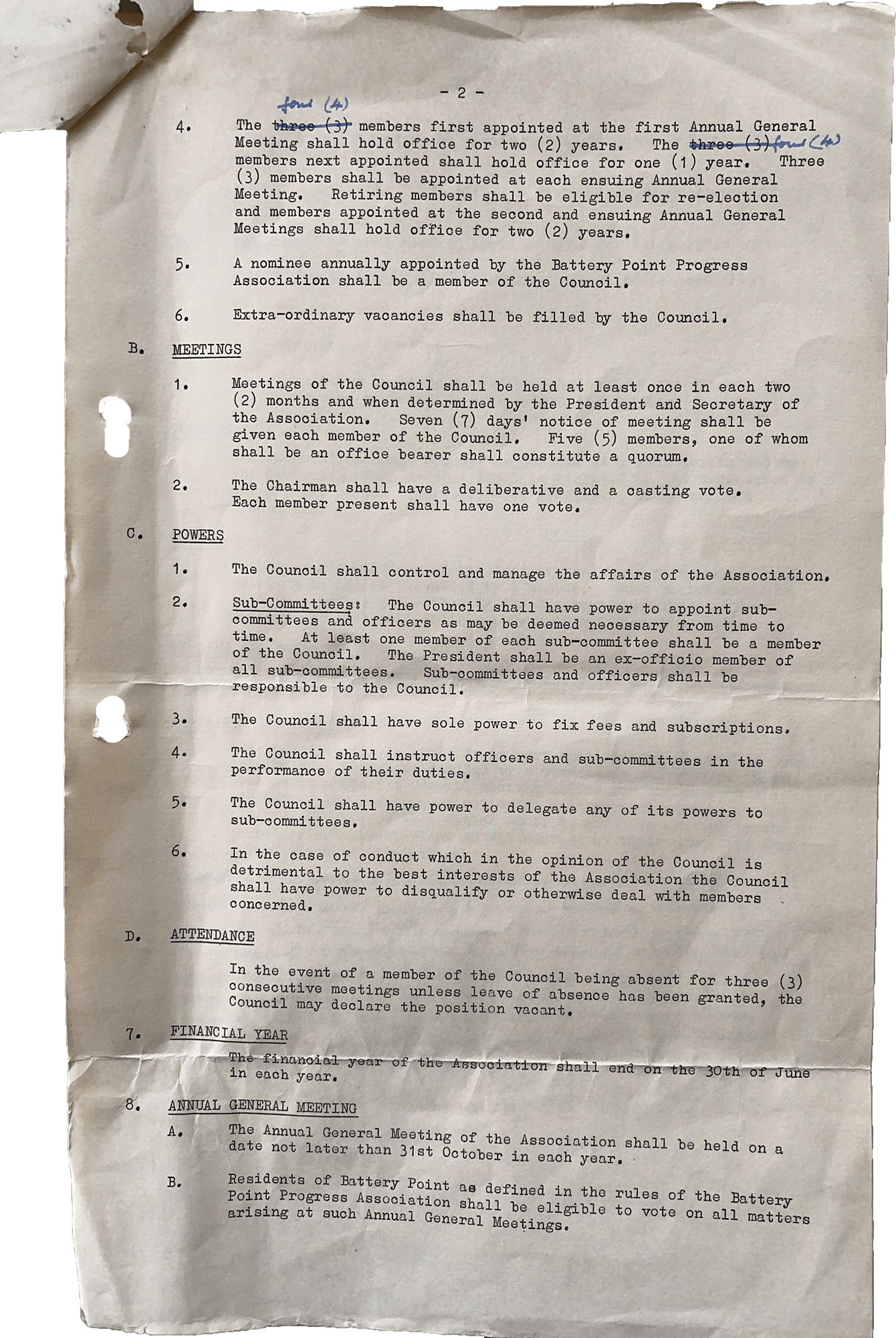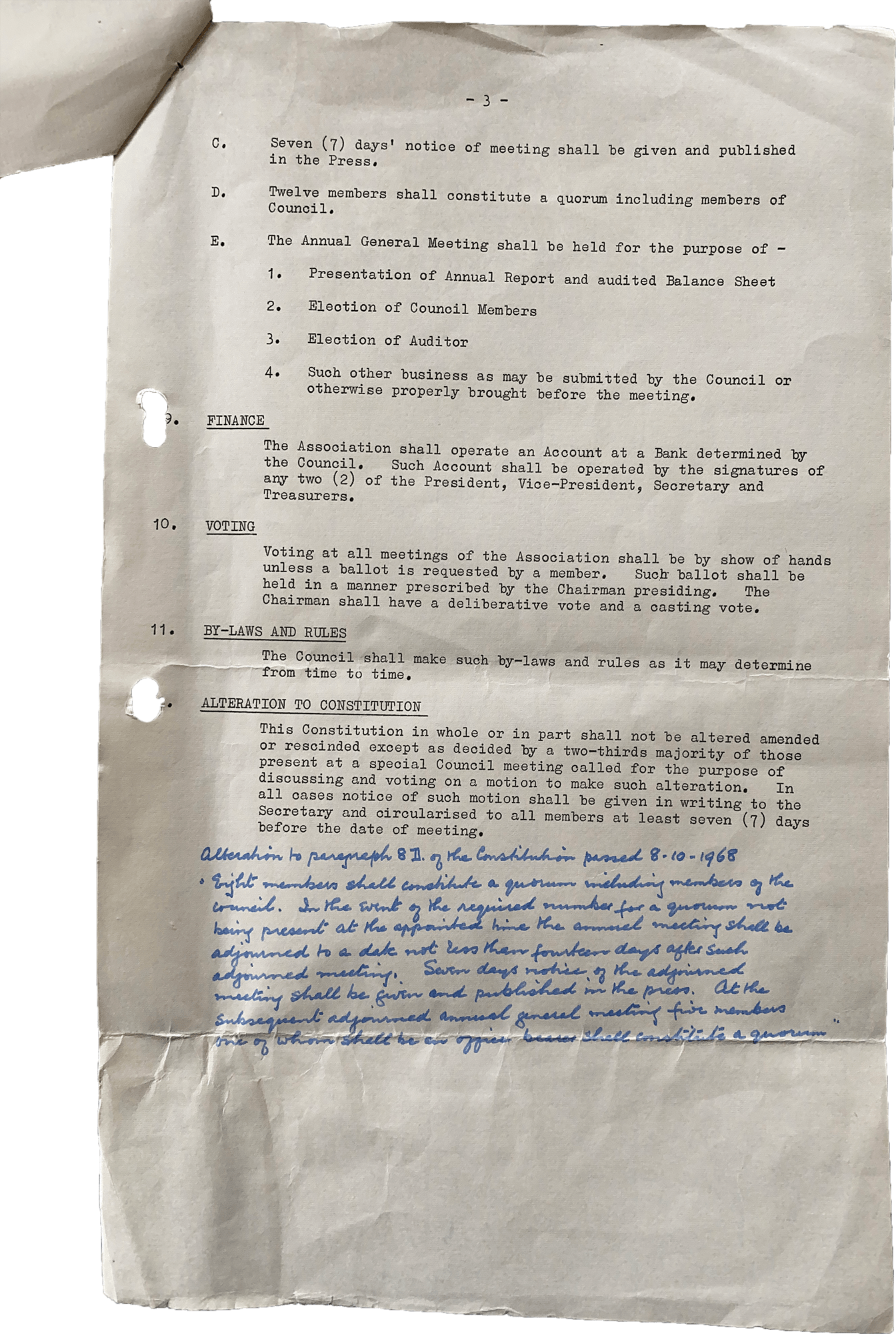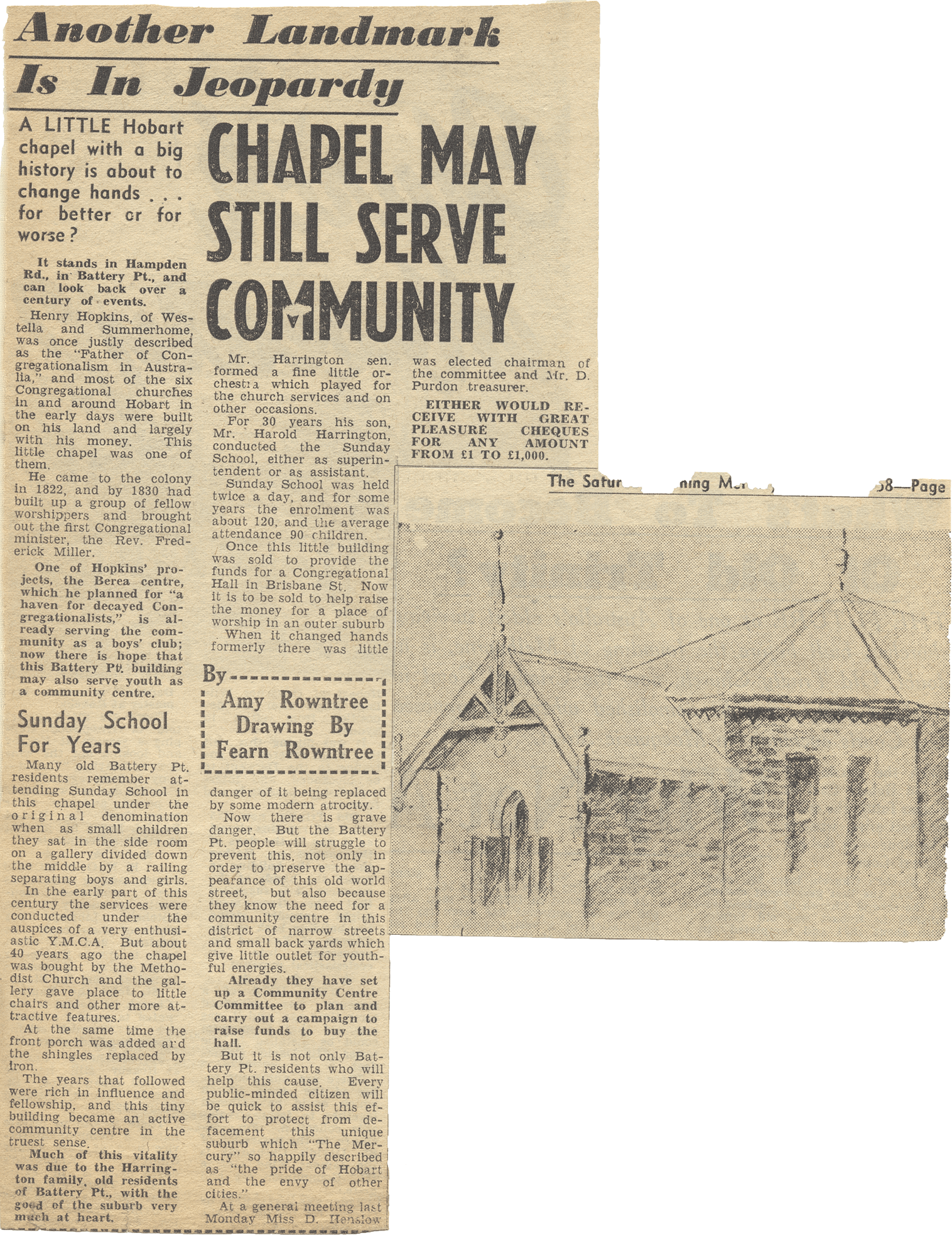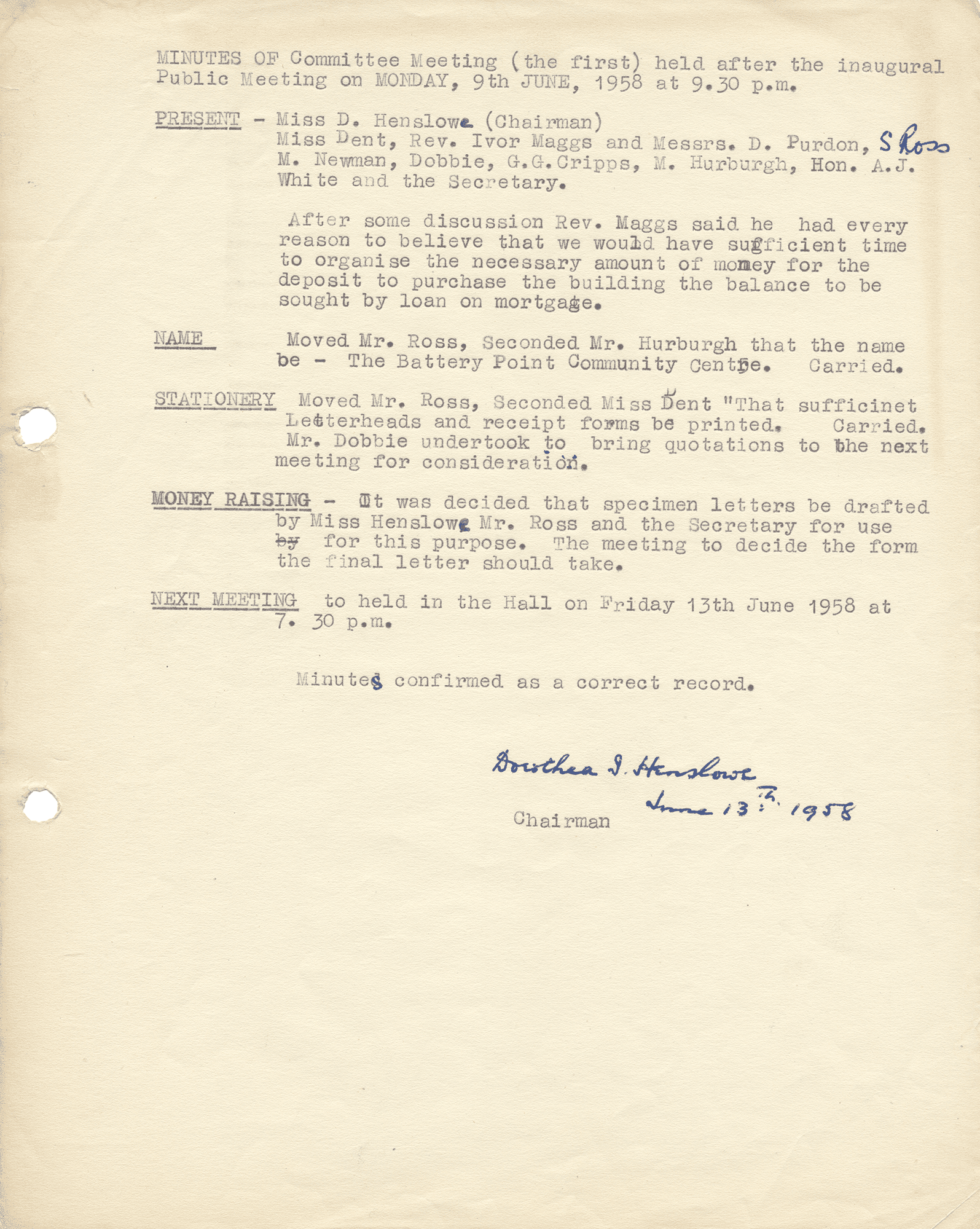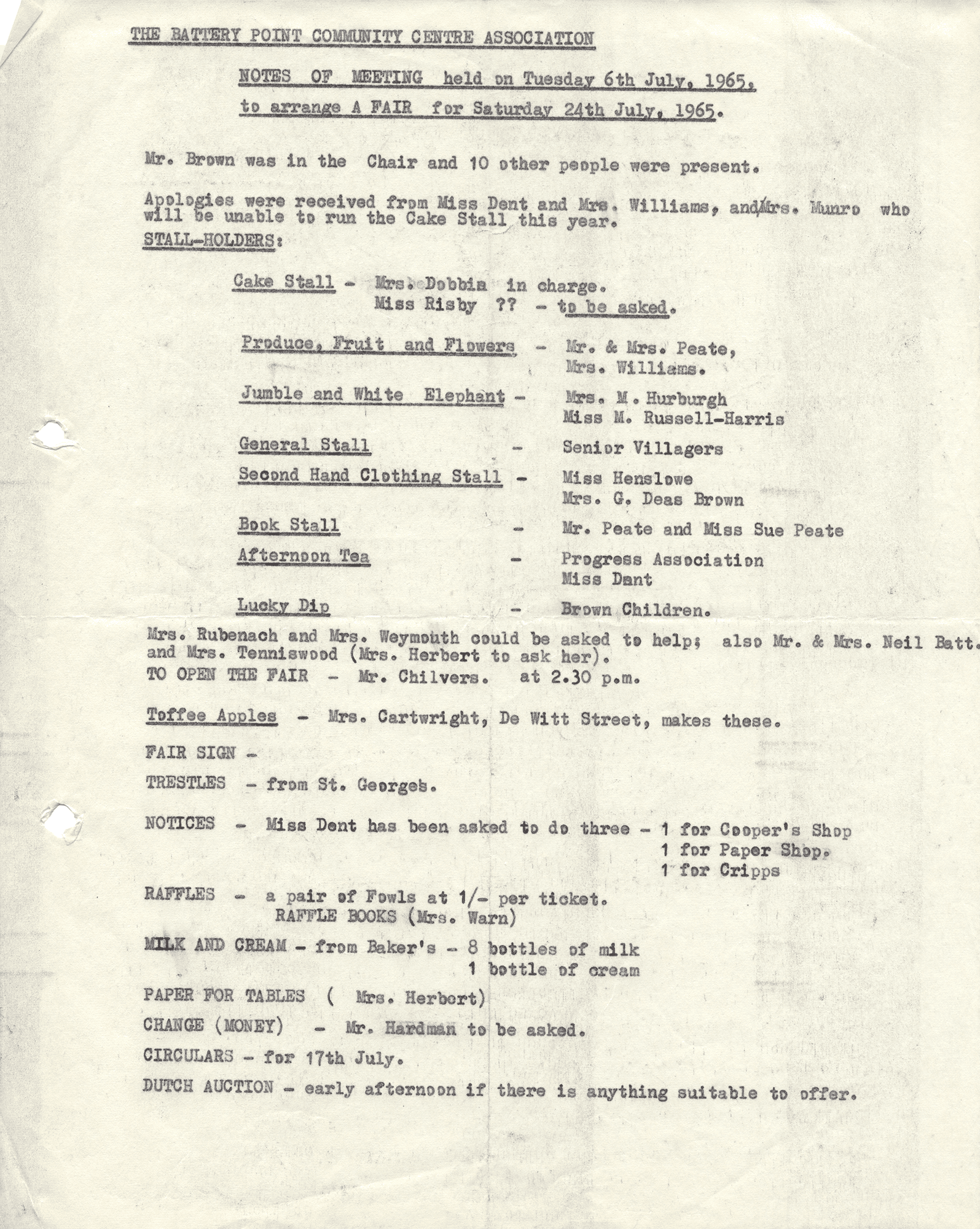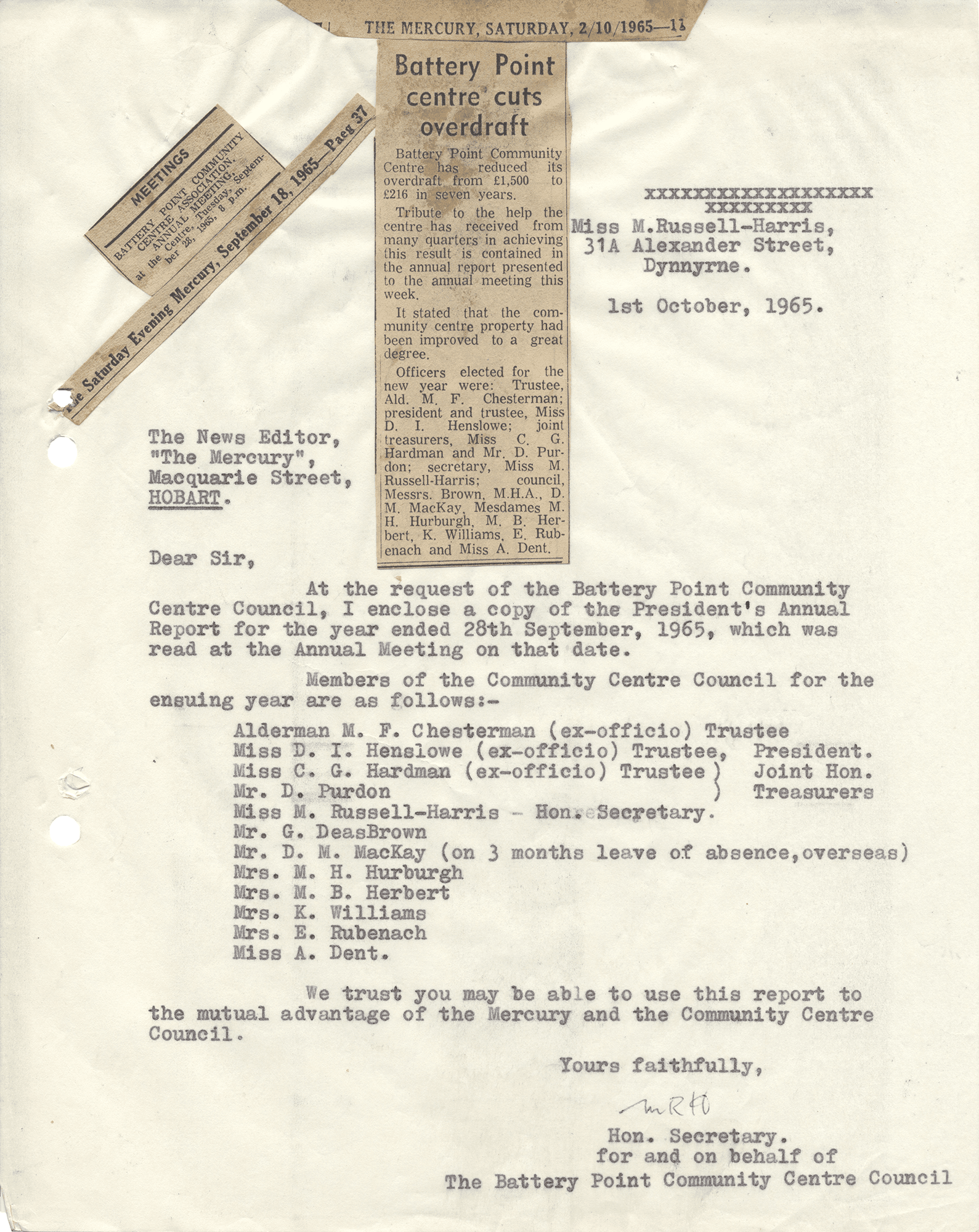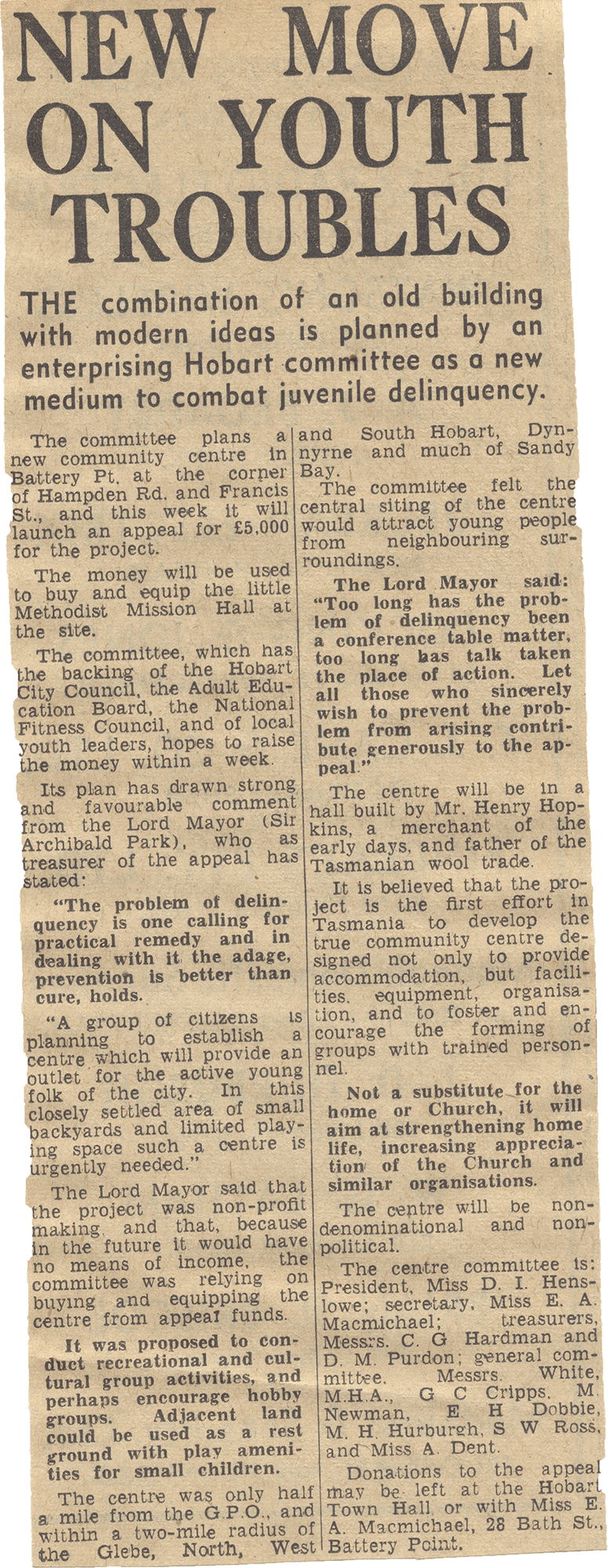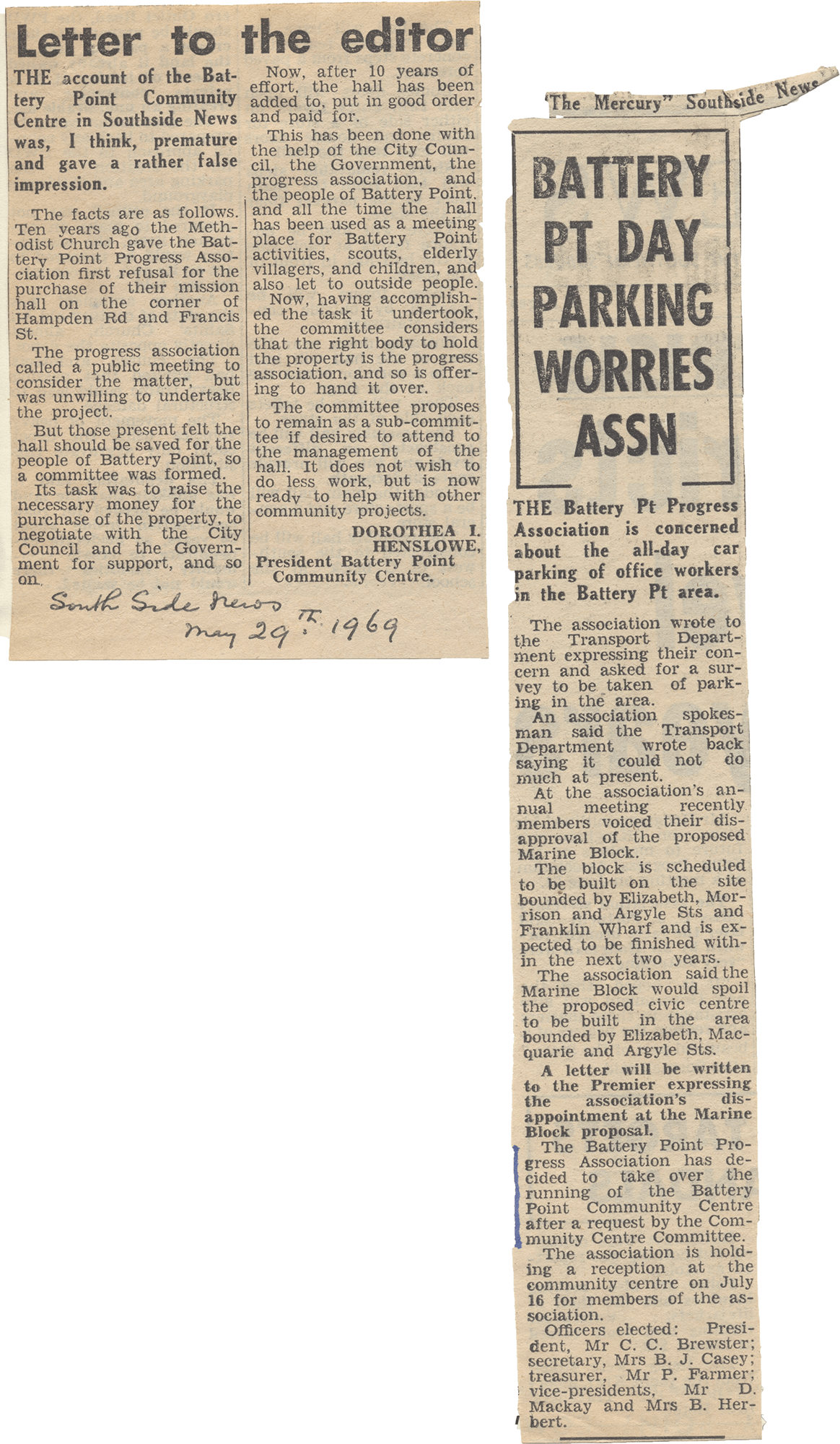The history of the hall in Hampden Road commences in 1834 with the formation of the Van Diemen’s Land Home Missionary and Christian Instruction Society in Australia. This group, under the auspices of the Congregational Church, ran Sunday Schools in Van Diemen’s Land, including one in Battery Point, probably from late 1830s. Initially rooms were hired in Battery Point but by 1847 the Congregationalists sought better Battery Point premises to accommodate the number of scholars. In 1849 the Congregationalists purchased the block of land on the south-east corner of the Hampden Road and Frances Street junction at a cost of 125 pounds and they spent another 250 pounds building a Sunday School on the site. By January 1850 the building, which appeared to be rather classical in design, was complete. Opening celebrations were held on Tuesday 5 February 1850 when about 100 scholars and visitors sat down to tea in the new school room.
The first Sunday School held in the building was on 10 February 1850, with a complement of 45 students and five teachers. The Reverend Miller preached the opening sermon (based on St Luke, Chapter 19) and prizes were delivered to the children by Mr Jennings, the first Sunday School Superintendent. The children sat on a gallery divided by a railing that separated girls and boys. It remained the only Sunday School in the area until the opening of St George’s Church later in 1850.
The Sunday School grew steadily and by the first half of the 1860s it included around 12 teachers with approximately 100 children. At that time the family names of students included Lindsay, Garth, Logan, Ross, Solomon and Garrett. Sunday School teachers met monthly and worked seriously. Interested visitors provided support for the teachers and students.
In 1866 a decision was taken to extend the original building. In September that year, the architect F Butler was engaged. He designed an attractive and aspirational Victorian building to replace (and incorporate) some of the earlier building. In keeping with the times, an outdoor ‘dunny’ stood in the fenced backyard of the Sunday School.
The Congregational Sunday School operated morning and afternoon till at least 1910. The program often included a sermon from a visiting preacher and sometimes a visit to the Brisbane Street Memorial Chapel or the nearby Bethel Chapel on the wharf. In the 1890s, Battery Point boys of the time traditionally met after Sunday School and either hung about the streets together or went ‘in a group’ down to the old Battery. There, they sometimes enjoyed a ‘trial of strength’, throwing what was described as cannon shot, or played soldiers. The lower part of what is now known as Princes Park was one of Battery Point’s less desirable areas for a very long time.
In the early years, when the weather was very wet and the roads bad, classes were cancelled. For many years an annual picnic treat was held, often at Sandy Bay Beach as well as an Anniversary Service commemorating the first February gathering.
The local press declared, ‘Though the benevolent efforts of the Congregationalists in this densely crowded locality were worthy of universal regard’, the Congregationalists needed eventually to divest themselves of the Hall in Battery Point. The plan was to provide funds for a Congregational Hall in Brisbane Street.
In October 1911, permission was given for the purchase of the building for use as a Methodist Mission Hall. This Hall continued to operate for around forty years – right into the 1950s. One hundred years of Sunday Schools in the Hall! Methodist Mission Halls were important places both for preaching and teaching the Gospel. A local Methodist guild was formed for financial and moral support; the Hobart – Sandy Bay Wesleyan Circuit was responsible for Battery Point Mission. Sundays usually involved general services and occasionally Holy Communion. Services were supported by an organ (at one time played by Miss Clarke) and, on occasion, a Mission orchestra under the baton of Mr J Harrington.
Historian Amy Rowntree wrote that ‘the chapel was bought by the Methodist Church and the gallery [of the Congregational Sunday School] gave place to little chairs and other more attractive features.’ She explained that at the same time the front porch was added and the roof shingles were replaced by iron.
For some years the Methodist Sunday School had an enrolment of about 120 with the average attendance being 90 children. From time to time, Sunday School students were publicly examined on their understanding of sermons. This was intended to fulfil the requirement of the Sunday School ‘to gratuitously communicate Christian instruction to children of all denominations.’
Under Methodist ownership the Hall began to be used more widely by the local community. In 1907, the Battery Point Homing Society (pigeons), under the imprimatur of President Mr Lodge, advertised their meetings at the Hall. The 1911 Temperance League meetings saw the Hall ‘filled to the doors.’ The Methodist Hall premises were used for Temperance League meetings and, for a brief period, a Temperance Society called Catch-My-Pal. Lectures and entertainments such as a 1912 Dickens Recital were held in the Hall. It was also a venue where political candidates could meet local electors as well as being used as a center for polling booths.
An Honour Roll was erected in 1917 listing the names of ‘fifteen lads who had been scholars in the Sunday School and obeyed the call of Empire.’
Amy Rowntree wrote that ‘the years [after the Methodist purchase] were rich in influence and fellowship, and this tiny building became an active community centre in the truest sense. Much of this vitality was due to the Harrington family, long-term residents of Battery Point, with the good of the suburb very much at heart. Mr Harrington senior formed a fine little orchestra which played for the church services and on other occasions.’
At this stage the Hampden Road side of the Hall looked much as it does now, but there was land between the Hall and Hampden Road, which has since been taken by road widening. The Community Centre Council also made over land to the City Council at the corner of Hampden Road and Frances Street so that the corner could be splayed, making the intersection safer. Outside lavatories stood in the back yard as well as at least one shed and a garage. These were removed as was the chimney and fireplace in the supper room.
Miss Dorothea Henslowe, quoted in Hudspeth and Scripps, discussed the issues of the Battery Point Hall:
‘… the Methodists found they had no adherents (in Battery Point), everyone seemed to be ‘nothing’ or Church of England or Roman Catholic. So, it was shut up and the ground round it was just a rubbish heap with an old loo in it in which I found boxes of old-hymn books. The only people that wanted it were the petrol companies. They wanted to pull it down and put a petrol station there as had been done on many corner sites.’
Later in 1958 the Sunday School building was put up for sale. Possibly this was the most critical time of the Halls’ history. Miss Henslowe, reported again in Hudspeth and Scripps Historical Research, stated:
‘People said it seemed rather a pity to pull it [the Hall] down – why didn’t the people of Battery Point buy it? Well it was very run down – the Progress Association had a meeting and they turned it down.’
A Progress Association meeting was held at which the purchasing of the Hall was discussed. Association President Mr. Brewster’s 1957/58 Annual Report, preserved in surviving minutes, read: ‘Your committee held a public meeting a fortnight ago, as a result of which the Battery Point Community Centre Committee was formed with the object of purchasing the Methodist Church Hall and developing the property as a Community Centre.’
Miss Henslowe continued her story in the interview recorded by Hudspeth and Scripps.
‘… The Chairman [of the Progress Association] said it was too big a job – you couldn’t use it as an ordinary hall unless you built on change rooms and toilets and so on – it needs a lot doing to it – and then they said “other business.” So I jumped up and said “you cannot go on to other business yet. I want us to go on with this. We cannot let it go” because at the time the children were playing in the gutters whom I was interested in – I said “they’ll get run over with the cars coming here for their petrol.” They said, “No, we have turned it down, but if you’d like to get a committee going, we’ll help you, but we’ll take no responsibility.”’
Miss Henslowe followed the Chairman’s suggestion and sought help from similarly minded people. On 9 June 1958, a Special Meeting decided the Hall should be purchased as a Community Centre. At that meeting, a Mercury newspaper report of 10 June 1958 reads: ‘A donation of 25 pounds from Mr G G Cripps started a fund for the hall and the Battery Point Progress Association donated another 50 pounds. Donations at last night’s meeting took the fund to more than 100 pounds. Officers Elected: Chairman Miss D Henslowe, Secretary Miss E MacMichael, Treasurer Mr D Purdon, Committee Miss A Dent, Messrs EH Dobbie, AJ White, G G Cripps, M Newman, M Hurburgh and L Rodd.’ Miss Henslowe remained as a very long-term Chairman.
During June 1958 the Community Association Committee appointed an honorary architect, Colin Philp, and LG Murdoch as an honorary lawyer and began preparing a constitution. By 11 July, the Battery Point Community Centre Association (BPCCA) had been registered as a non-profit company.
In December 1958 it was agreed that the two original trustees – Miss Dorothea Henslowe and Mr Cyril Hardman – would be joined by Alderman Max Chesterman (the HCC nominated trustee). These three served as Trustees of the Battery Point Community Centre for many years. Miss Henslowe reported in April 1959 that she and Mr Hardman had signed the Deed of Trust and thus the building was acquired from the Methodist Church for 3,032 pounds and ten shillings.
Mr Rice from the Town Hall had already ‘looked over the Hall’ and said what had to be done (to meet standards) and a building subcommittee of the BPCCA was formed. Financial help was imperative. Running costs, such as electricity and general repairs, land tax and rates were being levied. As well as asking for funds through door knocking local residents and local businesses, appeal brochures were sent to prominent Hobart business houses. The Fund Raising Committee also looked to local and State Government for support. The Premier promised to recommend that 1500 pounds be made available for the purchase and The Hobart City Council promised 1500 pounds. The BPPA ‘rubbed along’ with the BPCCA and made some financial donations to the Committee. For example, 50 pounds was passed over on 23 June 1968.
The first fundraising activity was a creche, held every Friday afternoon with volunteer carers. Response to the creche was poor and after some months it ceased. Fairs, film evenings, raffles, card evenings, and socials were held in an effort to raise funds to repay the loan. Used clothing sales resulted in lots of old clothes and shoes being left in the Hall. Sales took place on pension day with arrangements made for their removal, including a sale to the Flock Mills, for one pound 12 shillings and three pence.
Dancing classes rented the Hall (Mrs Kemp was charged five shillings per hour for ballet classes) as did girl guides, brownies and private parties (originally 30 shillings per night). The shed in the back garden was let out for parking (four shillings per week) as was a garden parking space (2/6 per week). A hockey club and a Wednesday evening Badminton Club paid five shillings per night rental. A Sea Rangers Group rented the Hall for seven shillings and sixpence per night. A Seniors Villagers Club was established and met alternate Thursdays from early 1961. The variety of tenants was wide. Right into the 1970s, fund raising, including regular cake stalls, were held with the purpose of paying back the loan which had been raised to buy and refurbish the Hall.
While funds needed to be raised to purchase the Hall, repairs were also necessary if the Hall was to be used to its best advantage. Miss Henslowe sought practical help to get the Community Centre into a more usable state. When her requests for assistance by the ‘older men’ in the village were not forthcoming, Miss Henslowe sought help from ‘big boys’ in the village. They helped her sand the Hall floor and generally helped to make the building more habitable. Larger building works, including replacement of the gutters and upgrading of kitchen and toilet facilities, meant that in late 1959 a tender of 1050 pounds was let for alterations to the Centre. An overdraft rather than a mortgage was taken with the ES&A Bank.
Assistance in furnishing the Hall was ongoing. in 1961 a dust pan and garbage bins were purchased, Fitzgeralds donated and fitted blinds for the new changing rooms, and committee members mended some of the old cedar forms which had been purchased from the Methodist church. Kitchen curtains, change room coat pegs and mirrors were donated. The BPPA donated cups, saucers and a teapot for the Hall and purchased and installed an urn and, in 1963, a stove. Chairs for the Hall were purchased at a sale held at Brighton Camp mid 1960 (sixty chairs at 47 shillings and sixpence each). A community drive for tables was instituted early in 1961 but most tables and cupboards were bought at auction. Card tables, however, were gifted from sources varying from the Country Women’s Association, the Prince of Wales Hotel and private homes. In 1961 Miss Cecily Shoobridge donated her piano to the Centre.
An unforeseen difficulty facing the Hall was vandalism and the Committee was faced with constant repairs. Though these were frequently financed by insurance, the Committee needed considerable patience, especially with regard to missing china and glasswear, and window and door breakages. The playground was regularly vandalised by children. Miss Henslowe became very concerned and in 1964 started a Play Group on Friday afternoons. Another ongoing challenge were the rates levied by the Council.
In October 1958, the Hobart City Council undertook to make and maintain a small park playground by the Hall. The fence to the back yard and the sheds were put up for tender: the fence sold for three pounds; the sheds and garage were removed. Using a bequest from the Estate of Mr Percy Ash, in 1961 the Hobart City Council put up a low stone wall, leveled and grassed the area, paved the area near the front door, and planted shrubs and a tree. In 1988 the grounds of the Community Centre, sometimes called the Frances Street Park, were designated ‘Henslowe Park’.
As early as 1961, investigations were being made about sound deflection in the main Hall, but heating was also a problem. Sunray Infrared overhead heaters controlled by pre-payment meters were installed in 1962 at a cost of 207 pounds.
The Christmas Party provided by the BPCCA for elderly local residents was supplemented from 1961 by a more general party to thank supporters and helpers. It became a regular Battery Point Christmas Party and was described as a sherry and savouries party. This party developed into the one Miss Henslowe described as ‘a Christmas party for all given by all’. The tradition developed into the event which continues today.
Although she was strict, Miss Henslowe felt the love of the local children. She explained: ‘They know I am on their side, which most adults are not, and they know I love them.’
One afternoon a week, a group of about 30 ‘underprivileged children, who would otherwise be playing on the streets’, turned up for playgroup activities and games followed by lemon syrup and biscuits. One evening a week a boys’ club took place. Ping pong was a popular activity – Miss Henslowe had organized a table! And again, lemon syrup cordial and biscuits provided refreshment. Norma Brown established a local Girl Guide Group which also met in the Hall. Miss Henslowe suggested the establishment of a Senior Citizens Group and local elderly citizens met weekly on Thursday afternoons into the 1980s.
Cleaning of the Hall was undertaken by a roster of Committee members. Miss Henslowe initially took bookings for the Hall herself. After some time, others were enlisted for this task and Mr Harrington at the shop opposite held the keys for the convenience of casual tenants.
The rentals were supplemented by what became regular donations from the Battery Point Group of the National Trust as well as some donations from the Battery Point Progress Association and the Senior Citizens group. Funds to maintain the building were always a problem and occasionally working bees by ‘local men’ and donations from the City Council allowed for urgent maintenance. From July 1961 community working bees painted the interior of the Hall. Problems with damp were continual. In 1970 and 1974 the Centre was painted inside and out. In 1980 volunteers again painted the inside. In 1971 new guttering and a weather guard were installed. Miss Henslowe proposed ‘a really good portrait of the Queen’ to be bought, framed and hung above the stage in the Hall.
The BPCCA Constitution noted that the basic Objects of the Association were to provide for educational, cultural and recreational activities for young people, for group activities for all local people and to provide and maintain the premises as a centre for carrying out the Objects. For some time in the 1960s, a Community Centre report was presented to the BPPA.
The Battery Point Group of the National Trust used the Hall for meetings from 1972. Other users included the Red Cross, Mummers Drama Group, the Tasmanian Environment Centre, a Chamber Music Group, the Tasmanian Philatelic Society, Sony Jose Dancing School and the National Trust Ladies Committee. By 1984 regular users of the Centre included Senior Villagers, who met on alternate Thursday afternoons, local Brownies and the BPPA.
The BPCCA met regularly. They needed to address problems caused by casual renters ranging from ‘damaging seats, stealing keys, breaking the Queens photograph and breaking into the cupboards and piano case.’ Sourcing reliable cleaners was an ongoing problem as well. One note records the ‘trouble caused by people giving wrong addresses and phone numbers.’
In 1971 it was resolved at meeting of the BPPA to have the Community Centre property registered under the Company’s Act in the name of the Progress Association. A 1974/75 plan for the Community Hall management to be vested in the BPPA foundered and a group described as Battery Point Council emerged as managers of the Hall. There was considerable dissent with the BPPA.
Planning for a Battery Point Walk commenced in June 1971. Tours, under the direction of Miss Henslowe and the auspices of the Battery Point Group of the National Trust, first took place during the Festival of Tasmania in January 1972.These walks grew in popularity and continued for many years allowing regular donations to be made to the BPCCA.
In time, the Trustees became older and succession planning became imperative. After the possibility of amalgamating the Community Hall Committee with the Progress Association foundered, the possibility of The National Trust running the Hall was investigated. On 6 November 1975, at a Public Meeting chaired by BPPA President Mr D Saunders, it was decided negotiations for the amalgamation of BPPA and BPCCC should be terminated and the trustees were instructed to hold the property on behalf of BPCCA. The three original trustees, Miss D Henslowe, Mr C Hardman and Mr M Chesterman were to be assisted by an elected committee. The 1975 Hall Trustees remained D Henslowe, M Chesterman, C Hardman and the local Committee consisting of B Herbert, E Hurburgh, Miss Dent, George Brown, G Forward, R Vincent and Dr Tenniswood was established.
In 1994, the BPCCA merged with the BPPA. The National Trust held the critical share in this arrangement. (Ann Brown represented the Trust on the management committee until the organizations decided to go their own ways). In 1994, the ‘ownership’ of the Battery Point Community Centre by the BPPA was confirmed and attention was focused on the dilapidated state of the building itself.
Peter Spratt and Associates undertook a structural and fabric conservation study on behalf of the BPPA. Peter Spratt’s engineering report noted poor quality sandstone, undamp-coursed walls and underfired original bricks. It indicated that flashings to the chimney and roof required attention, drainage needed venting, external walls needed repair and painting as did plinths and pointing. The BPPA applied to the National Trust Preservation Fund for assistance and an $8000 dollar for dollar grant from the National Trust assisted with Hall repairs.
Several community members over the next twenty-five years led forays into Hall repair and beautification. The ‘clutter of lights and hanging heaters from the ceiling’ noted by Peter Spratt were attended to tastefully and the small rear room fitted as a meeting room. Ongoing funds were essential to make the Hall a rentable place. The local press noted fundraising events in 1994-1998 in aid of renewal of the Hall. In addition, HCC grants became available to community organizations and other grants were forthcoming.
In 2017, the Battery Point Community Association (renamed in 2015) received a grant of $23,647 to undertake repairs, re-paint the exterior and interior of the Hall and update the kitchen. Today, the Hall is a popular venue for a range of events and continues to play a central role in the life of the community.

